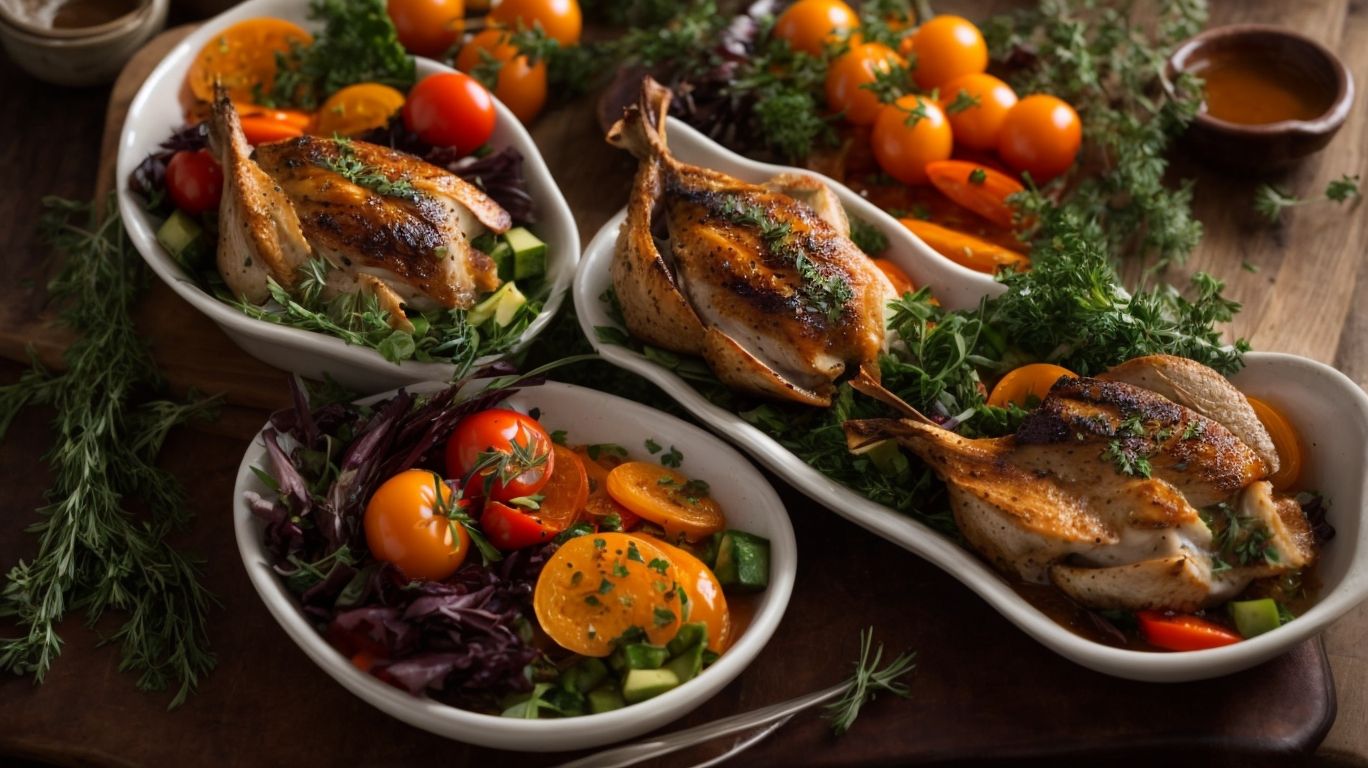How to Bake Quail?
Looking to add a touch of elegance to your culinary repertoire?
Explore why baking quail is a fantastic choice, from its unique flavor and texture to its nutritional benefits.
Walk through everything you need to know, from preparing the quail to serving suggestions and troubleshooting common baking mistakes.
Get ready to impress your guests with this delicious and versatile dish!
Key Takeaways:
Why Bake Quail?
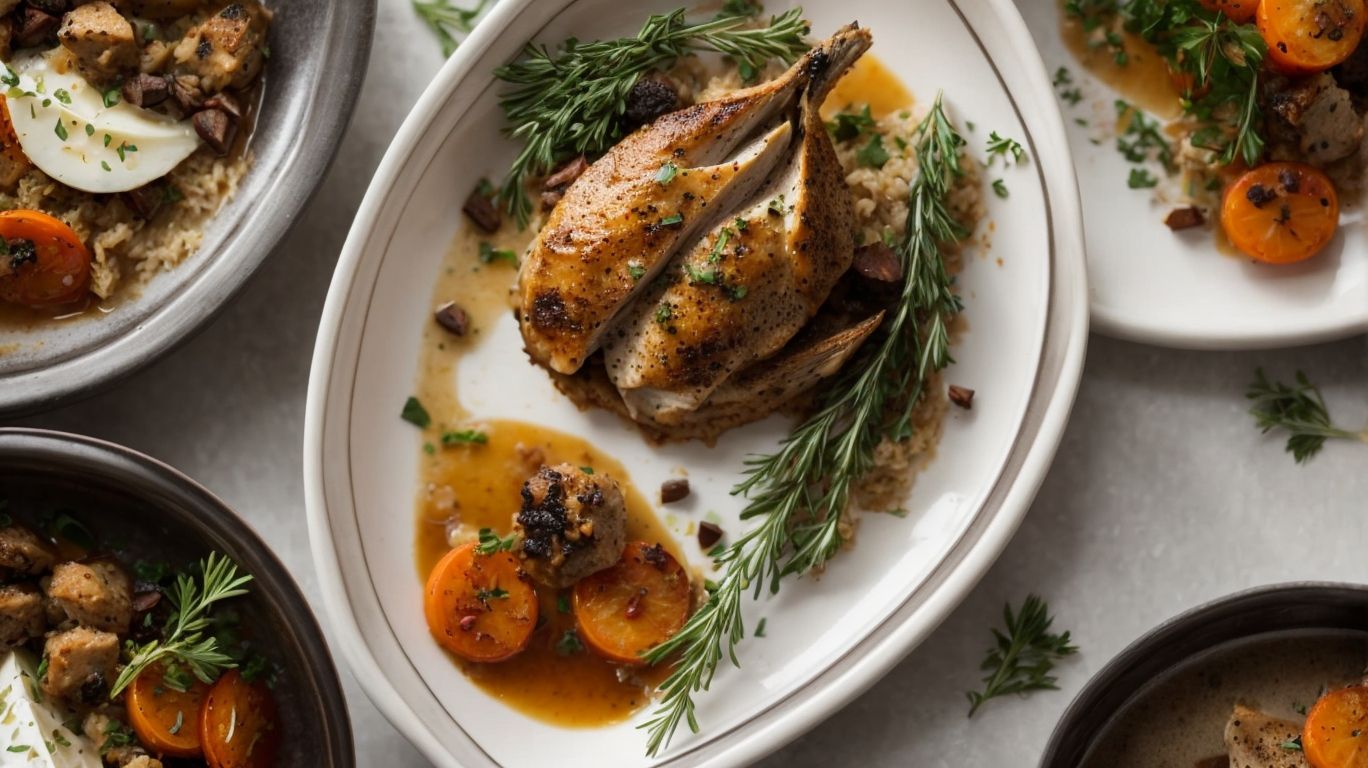
Credits: Poormet.Com – Jeremy Martin
Baking quail offers a unique culinary experience, combining distinctive flavors and textures that elevate traditional poultry dishes.
Unlike larger birds like chicken or turkey, quail meat has a delicate, tender quality that lends itself well to baking, preserving its juiciness and enhancing its natural flavors. The smaller size of quail also allows for quicker and more even cooking, making it an ideal choice for a hassle-free roast.
Roasting quail in the oven not only results in a perfectly golden and crispy skin, but also locks in the juices, ensuring a moist and flavorful end result.
Unique Flavor and Texture
Quail boasts a rich, succulent meat with a delicate texture that pairs perfectly with buttery notes and a hint of olive oil, creating a harmonious blend of flavors.
This small game bird offers a unique flavor profile that can be described as a combination of poultry sweetness and a slight gamey taste, making it stand out in various dishes. Its tenderness allows for quick cooking methods like grilling, pan-searing, or roasting, while still retaining its juiciness. The richness of quail meat intensifies when prepared with a touch of butter, enhancing its natural taste. When infused with a drizzle of high-quality olive oil, it adds depth and enhances the overall dining experience.
Nutritional Benefits
Quail meat is a nutritious option, rich in essential proteins and vitamins, and its preparation using high heat methods like oven roasting with a touch of olive oil preserves its nutritional value.
Quail meat is a great source of lean protein, making it an excellent choice for those looking to increase their protein intake without excess fat. It is packed with vitamins such as B vitamins, particularly B12, which is crucial for energy production and nerve function.
When cooked at high temperatures, quail meat retains its tender texture and unique flavor, especially when combined with a drizzle of olive oil providing heart-healthy monounsaturated fats. This cooking method helps lock in the nutrients, ensuring you get the maximum nutritional benefit from your meal.
Versatility in Cooking Methods
Quail’s versatility extends to various cooking methods, from quick high-temperature roasting to slow marination in balsamic vinegar, offering a spectrum of flavors and textures to experiment with.
High-temperature roasting is ideal for those seeking a crispy exterior while maintaining a tender interior, perfect for quick yet flavorful meals. On the other hand, marinating quail in balsamic vinegar showcases the meat’s ability to absorb rich flavors over time, resulting in a more complex taste profile.
Whether you prefer grilling, pan-searing, or even braising, quail’s adaptable nature makes it a versatile ingredient, suitable for both fancy dinner parties and relaxed weeknight dinners alike. Its petite size also allows for creative presentations, making it a culinary delight for both home cooks and professional chefs.
What You’ll Need for Baking Quail
To bake quail successfully, you’ll need a selection of ingredients and precise instructions to ensure a flavorful and tender outcome that delights the palate.
When preparing to bake quail, gather quail meat, olive oil, garlic cloves, fresh herbs like thyme and rosemary, lemon juice, salt, and black pepper. Begin by preheating your oven and marinating the quail in a mixture of olive oil, minced garlic, herbs, lemon juice, salt, and pepper. Allow the flavors to meld together for at least an hour. Once marinated, transfer the quail to a baking dish, ensuring they are evenly spaced for thorough cooking. Roast in the oven until the quail’s internal temperature reaches a safe level, usually around 165°F. Serve hot, and enjoy the succulent flavors of your perfectly baked quail.
Ingredients
The key ingredients for baking quail include fresh quail, aromatic celery, a savory honey BBQ sauce, and Asian-inspired seasonings for a fusion of flavors.
In terms of preparing fresh quail for baking, it is crucial to ensure that the meat is of high quality and sourced from reputable suppliers. The freshness of the quail meat will greatly impact the final taste and texture of the dish. Pairing the quail with aromatic celery not only adds a delightful crunch but also infuses a subtle herbaceous note to complement the rich flavor of the meat.
To enhance the overall taste profile, a savory honey BBQ sauce can be brushed onto the quail, creating a sticky glaze that caramelizes beautifully during baking, adding a sweet and tangy element to the dish. Experimenting with Asian-inspired seasonings such as soy sauce, ginger, and five-spice powder can elevate the flavors with a unique and exotic twist, perfect for those who enjoy fusion cuisine.
Equipment
Prepare for baking quail by ensuring you have the necessary equipment on hand, such as a quality roasting pan, a reliable oven, and tools suitable for cooking at high temperatures.
When selecting a roasting pan, opt for one that is sturdy and large enough to accommodate the quail without overcrowding, allowing for even heat distribution during the baking process. It’s essential to preheat your oven to the recommended temperature before placing the quail inside to ensure proper and consistent cooking. Make sure you have heat-resistant gloves or mitts, along with tongs or a spatula, to handle the high temperatures safely and efficiently while preparing and serving the baked quail.
Preparing the Quail
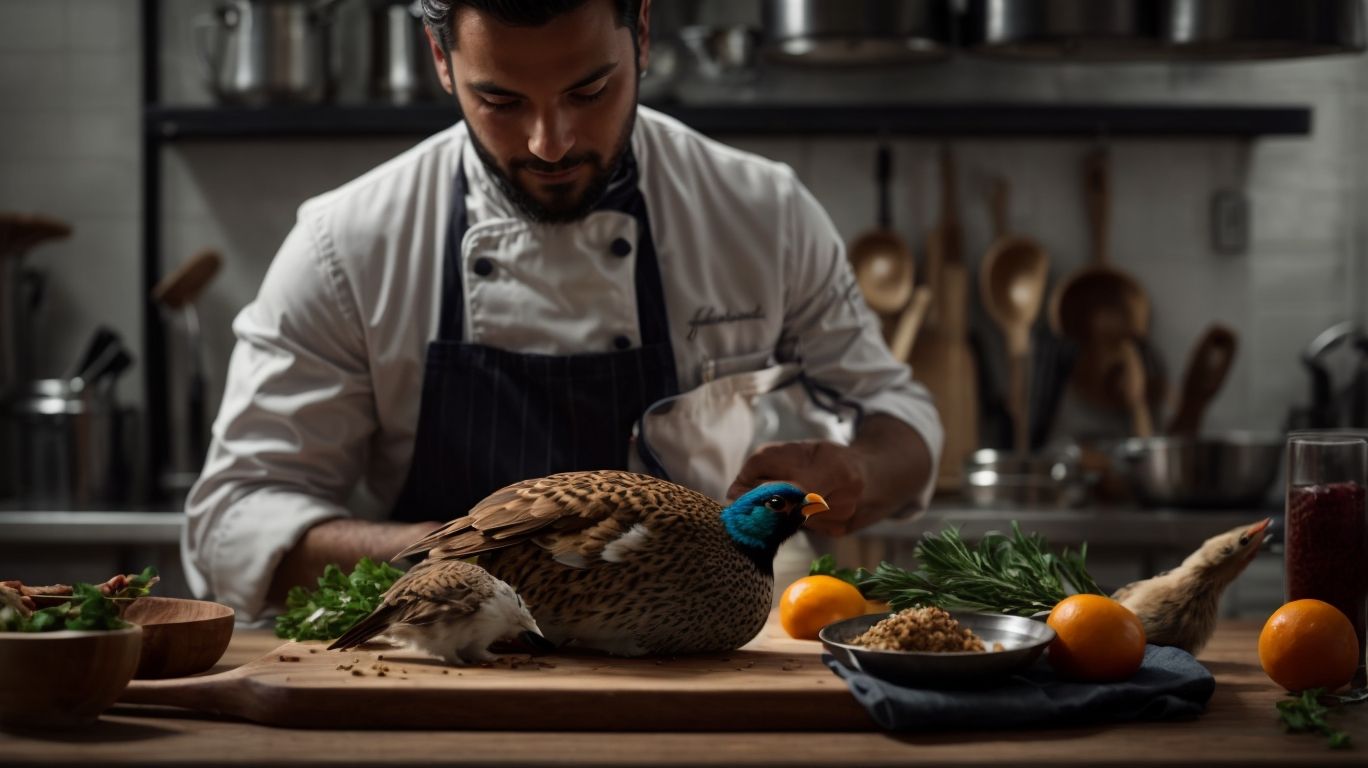
Credits: Poormet.Com – Dylan Hill
Properly preparing quail involves marinating the meat to enhance its flavors, infusing it with aromatic garlic and tenderizing techniques for a succulent dining experience.
Marinating is a crucial step in the preparation process as it allows the meat to soak up the flavors of the marinade, resulting in a richer taste profile. You can create a marinade using a mix of olive oil, garlic, fresh herbs, and citrus for a zesty kick.
Adding garlic not only enhances the taste but also contributes to the overall aroma of the dish. The pungent flavor of garlic complements the delicate nature of quail meat, creating a harmonious blend of flavors.
To ensure the quail remains tender after baking, consider using gentle cooking methods such as roasting at a lower temperature or wrapping the meat in foil while it cooks.
Cleaning and Trimming
Before baking quail, meticulously clean and trim the bird, ensuring it is free of feathers and properly plucked, especially when dealing with unique species like those from Valley regions.
Start by rinsing the quail under cool water, removing any visible dirt or debris. After rinsing, pat the quail dry with a paper towel. Next, carefully pluck out any remaining feathers using tweezers or a gentle pulling motion. Take care not to tear the skin while plucking.
Use a sharp knife to trim excess fat and any blemishes from the quail’s skin. Pay attention to the wings and legs, ensuring they are neat and uniform in appearance. Trim any protruding bones or cartilage that may affect the bird’s presentation when cooked.
Marinating Options
Explore a variety of marinating options for quail, such as citrus-infused blends with orange and lemon, or savory glazes that enhance the bird’s natural flavors during cooking.
When considering citrus-based marinades for quail, the acidity of oranges and lemons adds a bright and zesty kick that complements the delicate meat of this small bird. These fruits not only infuse a refreshing taste into the quail but also help tenderize the meat, resulting in a juicy and flavorful dish.
Alternatively, opting for a rich glaze can bring a whole new dimension to your quail dish. A balsamic glaze, for instance, creates a sweet and tangy coating that caramelizes beautifully during cooking, adding depth and complexity to each bite.
Baking Quail: Step by Step
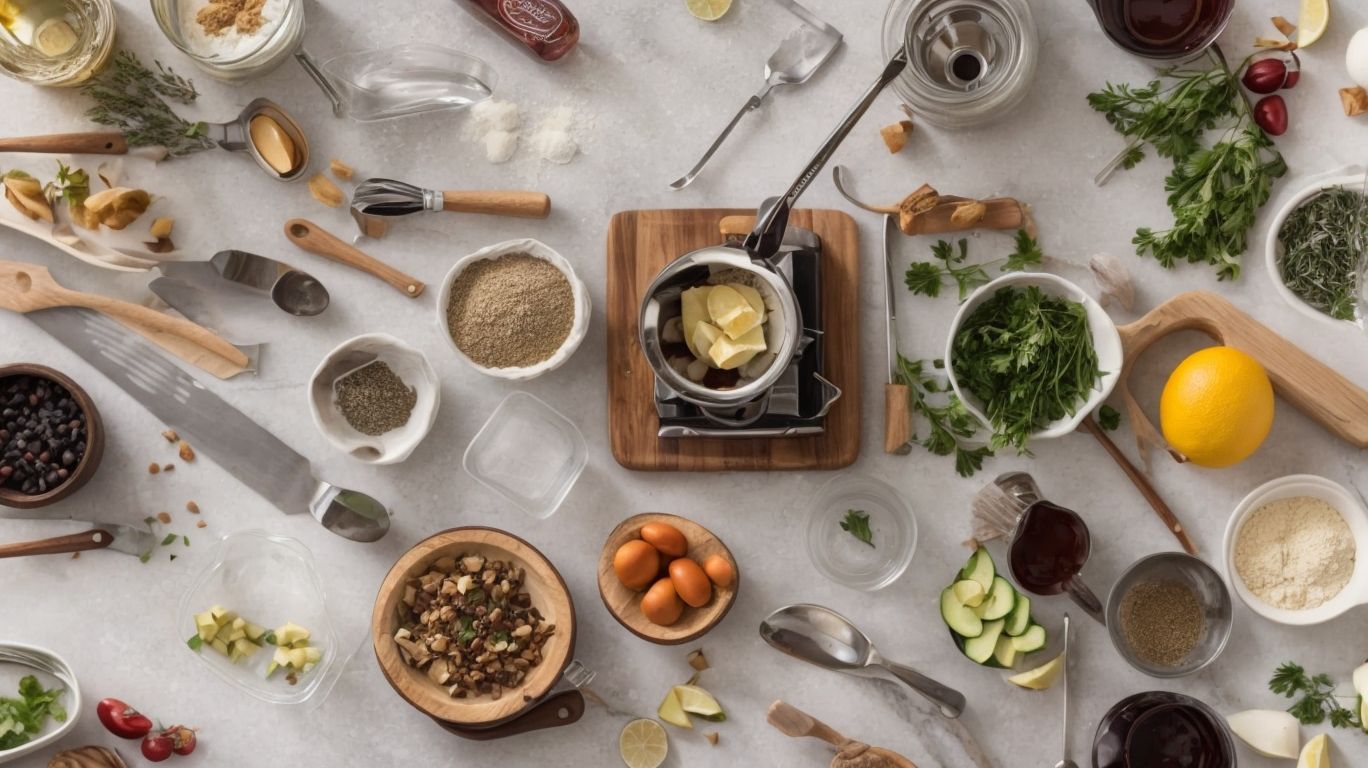
Credits: Poormet.Com – Zachary Adams
Baking quail requires a systematic approach, from seasoning the birds to setting the optimal temperature in the oven for a perfectly cooked and flavorful dish.
To start, preheat your oven to 425°F and ensure it is well-ventilated. Next, thoroughly clean the quail, removing any excess feathers or unwanted parts. Once cleaned, pat the quail dry with paper towels. Season the birds generously with a mixture of salt, pepper, and your choice of herbs or spices, ensuring to coat them inside and out. Place the seasoned quail on a baking sheet or in a baking dish, making sure they are not overcrowded.
When ready, insert a food thermometer into the thickest part of the quail to monitor the internal temperature. Remember to baste the birds occasionally with melted butter or olive oil to keep them moist during the cooking process. Bake the quail in the preheated oven for around 25-30 minutes, or until the internal temperature reaches 165°F for safe consumption.
Preparing the Oven
Prepare the oven for baking quail by preheating it to high heat, and consider adding aromatic elements like rosemary and white wine to infuse the cooking environment with rich flavors.
Preheating the oven is a crucial step to ensure that the quail cooks evenly and retains its juiciness. By setting the oven to a high temperature, typically around 450°F, you create the perfect environment for a crispy exterior while keeping the meat tender.
When incorporating aromatic elements like rosemary, you not only enhance the flavor of the quail but also fill your kitchen with delightful scents that set the mood for a gourmet meal experience. White wine, with its acidic and fruity notes, can further elevate the taste profile of the dish, adding depth and complexity.
Seasoning and Stuffing the Quail
Enhance the flavor profile of quail by seasoning and stuffing the birds with aromatic ingredients such as ginger, garlic sauce, and a touch of sesame oil for a vibrant and savory outcome.
Start by preparing a mixture of finely chopped ginger and garlic sauce along with a drizzle of sesame oil. Carefully season the quail with salt and pepper before gently rubbing this mixture inside the cavity of each bird.
Next, consider adding some diced vegetables like onions, carrots, and celery to the stuffing mixture for added flavor and texture. Stuff the quail with this aromatic blend, ensuring to pack it firmly but not too tightly to allow for even cooking.
Once the quail are generously stuffed, place them in a baking dish and drizzle a bit more sesame oil over the top for added moisture and richness.
Baking Time and Temperature
Achieve the perfect doneness for quail by following precise baking times and maintaining high temperatures throughout the cooking process to ensure juicy and flavorful results.
For optimal results, when baking whole quails, preheat your oven to 450°F (230°C) to get that ideal crispy exterior while keeping the meat tender and succulent. Allow the quail to cook for about 25-30 minutes or until the internal temperature reaches 165°F (74°C) for safe consumption. If you’re working with quail pieces, adjust the baking time accordingly to ensure they are cooked through but not overdone. Remember that maintaining high heat levels consistently is key to capturing the full flavor potential of this delicate poultry.
How to Know When the Quail is Done
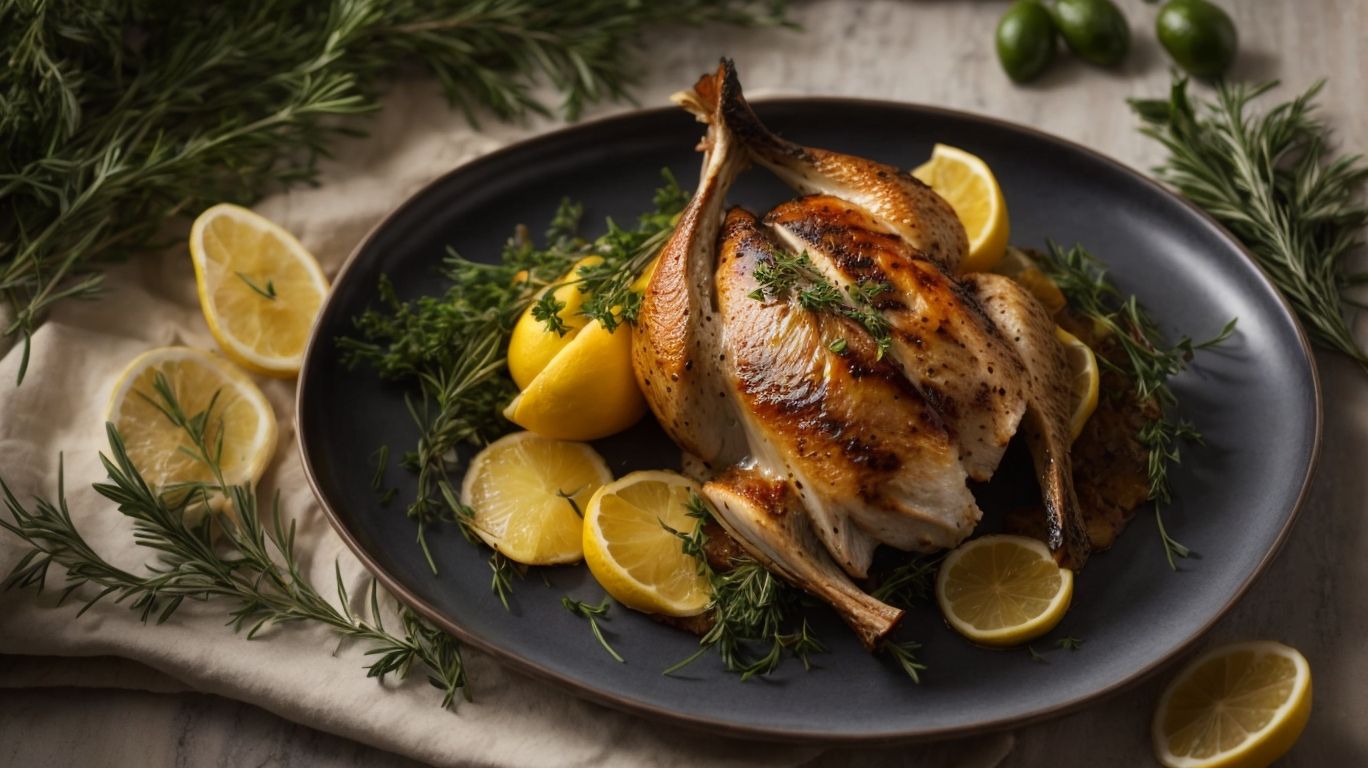
Credits: Poormet.Com – Noah Lopez
Determining the readiness of quail involves assessing factors like resting time, salt penetration, and the buttery finish that signifies a perfectly cooked bird.
Once the quail has been cooked to the recommended internal temperature, it is crucial to let it rest for a few minutes. During this resting period, the residual heat continues to cook the meat gently, allowing the juices to redistribute and settle. This resting time contributes significantly to the overall tenderness and juiciness of the quail.
- Salt absorption: A well-cooked quail not only reflects the seasoning on the surface but also boasts a balanced salt penetration throughout the meat, enhancing its flavor profile.
- Buttery texture: The ideal quail will have a moist, tender texture, reminiscent of butter, ensuring a delightful eating experience.
Serving Suggestions and Pairings
When serving quail, consider pairing it with complementary dishes like chardonnay wine, creamy camembert cheese, and flavorful grits to create a well-rounded and satisfying meal experience.
Chardonnay wine’s crisp and fruity notes beautifully complement the delicate flavor of quail, enhancing the dining experience with its refreshing quality. Camembert cheese adds a creamy richness that balances the gamey taste of the quail, creating a luxurious texture combination.
Pairing the dish with grits, known for their versatility and ability to absorb flavors, further elevates the meal by providing a warm and comforting element.
For a complete dining experience, consider serving a side of roasted vegetables or a fresh arugula salad to add a touch of freshness and color to the plate.
Side Dishes
Elevate the dining experience with delectable side dishes for quail, such as roasted pecans, citrus-infused oranges, and Asian-inspired accompaniments that complement the bird’s flavors.
Roasted pecans add a delightful crunch and nuttiness to the dish, creating a harmonious blend of textures. Meanwhile, the zesty citrus notes from the oranges provide a refreshing contrast that cuts through the richness of the quail’s flavors. For those looking to infuse some international flair, consider incorporating Asian-style preparations like soy-glazed bok choy or ginger-infused fried rice, adding depth and complexity to the overall meal.
Wine Pairings
Opt for wine pairings like balsamic vinegar-infused varieties, Normandy blends, or selections recommended by culinary experts like Hank Shaw to complement the nuanced flavors of quail dishes.
When looking to elevate the dining experience with quail, pairing it with wines that have a balsamic vinegar-infused undertone can create a harmonious balance of flavors. Normandy blends, known for their apple and pear notes, offer a refreshing contrast to the richness of quail meat.
Culinary personalities such as Hank Shaw often suggest specific wine pairings that perfectly enhance the delicate taste of quail. Their expertise can lead you to undiscovered wine gems that bring out the best in every bite.
Troubleshooting Common Baking Mistakes

Credits: Poormet.Com – Nicholas Williams
Avoid common pitfalls when baking quail by addressing issues like overcooking due to excessive heat, butter burnout, or inadequate seasoning that can impact the final dish’s quality.
One way to prevent overcooking the quail is by using a meat thermometer to ensure it reaches an internal temperature of 165°F without surpassing it.
When working with butter, opt for clarified butter as it has a higher smoke point, reducing the risk of burnout and imparting a rich flavor to the dish.
To enhance the flavor profile, create a seasoning blend with herbs like rosemary, thyme, and garlic powder, ensuring each quail is generously coated before baking.
Final Thoughts and Tips
Quail baking offers a delicious culinary journey enriched with aromatic valley flavors, hints of lavender balsamic, and the richness of olive oil, creating a memorable dining experience.
Delving into the world of quail baking unveils a symphony of taste and aroma that transport you to the scenic valleys with every bite. The delicate balance between the earthy essence of the quail meat and the sophisticated blend of lavender-infused balsamic is a true homage to culinary artistry.
For those seeking to elevate their quail baking experience further, opting for a high-quality premium olive oil from the fruitful groves of the Mediterranean can add a harmonious depth of flavor.
Frequently Asked Questions
What is the best way to prepare quail for baking?
The best way to prepare quail for baking is to marinate it in your desired flavors for at least an hour before cooking.
How do I know when quail is cooked to perfection?
Quail should be cooked to an internal temperature of 165°F (74°C) for safe consumption. You can also check for doneness by cutting into the thickest part of the bird and ensuring that the juices run clear.
Can I use a regular baking pan to bake quail?
Yes, you can use a regular baking pan or even a cast iron skillet to bake quail. Just make sure to grease the pan beforehand to prevent the quail from sticking.
What are some popular flavor combinations for baked quail?
Some popular flavor combinations for baked quail include garlic and herb, lemon and rosemary, and honey and Dijon mustard. Get creative and experiment with your favorite flavors!
How do I prevent quail from drying out while baking?
To prevent quail from drying out while baking, you can cover it with aluminum foil for the first half of the cooking time. Then, remove the foil and continue baking to allow the skin to crisp up.
Can I stuff quail before baking?
Yes, you can stuff quail before baking for added flavor. Make sure to use a thermometer to ensure that the stuffing reaches a safe internal temperature of 165°F (74°C).

